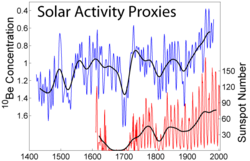Beryllium-10
Beryllium-10 (10Be) is a radioisotope of beryllium. It is formed in the Earth's atmosphere mainly by cosmic ray spallation of nitrogen and oxygen.[1][2][3] Beryllium-10 has a half-life of 1.39 × 106 years. It decays by beta decay to boron-10. It has a maximum energy of 556.2 keV. It decays through the reaction 10Be→10B + e−.[4][5]
10Be and its daughter product have been used to study soil erosion, soil formation from regolith, the development of lateritic soils and the age of ice cores. It is also formed in nuclear explosions by a reaction of fast neutrons with 13C in the carbon dioxide in air.[6]
Beryllium-10 Media
References
- ↑ Kovaltsov, Gennady A.; Usoskin, Ilya G. (2010). "A new 3D numerical model of cosmogenic nuclide 10Be production in the atmosphere". Earth and Planetary Science Letters. 291 (1–4): 182–188. Bibcode:2010E&PSL.291..182K. doi:10.1016/j.epsl.2010.01.011.
- ↑ Beer, Jürg; McCracken, Ken; von Steiger, Rudolf (2012). Cosmogenic Radionuclides. Physics of Earth and Space Environments. Bibcode:2012crta.book.....B. doi:10.1007/978-3-642-14651-0. ISBN 978-3-642-14650-3. ISSN 1610-1677. S2CID 55739885.
- ↑ Poluianov, S. V.; Kovaltsov, G. A.; Mishev, A. L.; Usoskin, I. G. (2016-07-16). "Production of cosmogenic isotopes 7 Be, 10 Be, 14 C, 22 Na, and 36 Cl in the atmosphere: Altitudinal profiles of yield functions: COSMOGENIC ISOTOPES IN THE ATMOSPHERE". Journal of Geophysical Research: Atmospheres. 121 (13): 8125–8136. arXiv:1606.05899. doi:10.1002/2016JD025034. S2CID 119301845.[dead link]
- ↑ Korschinek, G.; Bergmaier, A.; Faestermann, T.; Gerstmann, U. C.; Knie, K.; Rugel, G.; Wallner, A.; Dillmann, I.; Dollinger, G. (2010-01-15). "A new value for the half-life of 10Be by Heavy-Ion Elastic Recoil Detection and liquid scintillation counting". Nuclear Instruments and Methods in Physics Research Section B: Beam Interactions with Materials and Atoms. 268 (2): 187–191. Bibcode:2010NIMPB.268..187K. doi:10.1016/j.nimb.2009.09.020. ISSN 0168-583X.
- ↑ Chmeleff, Jérôme; von Blanckenburg, Friedhelm; Kossert, Karsten; Jakob, Dieter (2010). "Determination of the 10Be half-life by multicollector ICP-MS and liquid scintillation counting". Nuclear Instruments and Methods in Physics Research Section B: Beam Interactions with Materials and Atoms. 268 (2): 192–199. Bibcode:2010NIMPB.268..192C. doi:10.1016/j.nimb.2009.09.012.
- ↑ Balco, Greg; Shuster, David L. (2009). "26Al–10Be–21Ne burial dating". Earth and Planetary Science Letters. 286 (3–4): 570–575. Bibcode:2009E&PSL.286..570B. doi:10.1016/j.epsl.2009.07.025.
